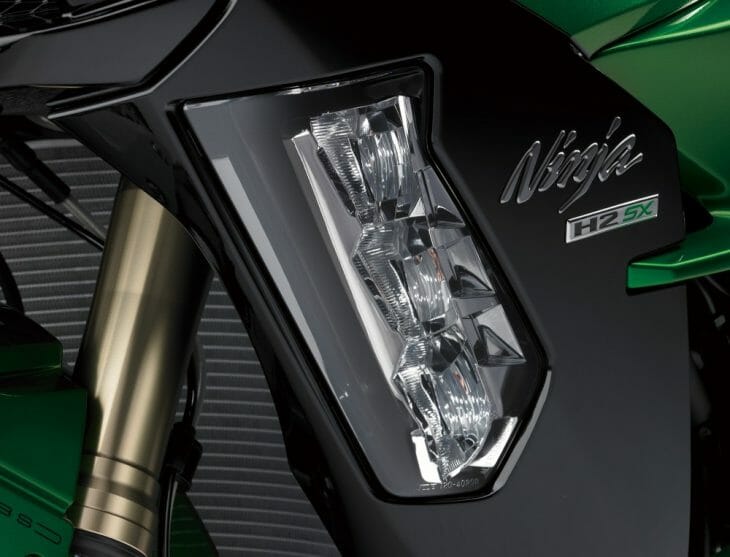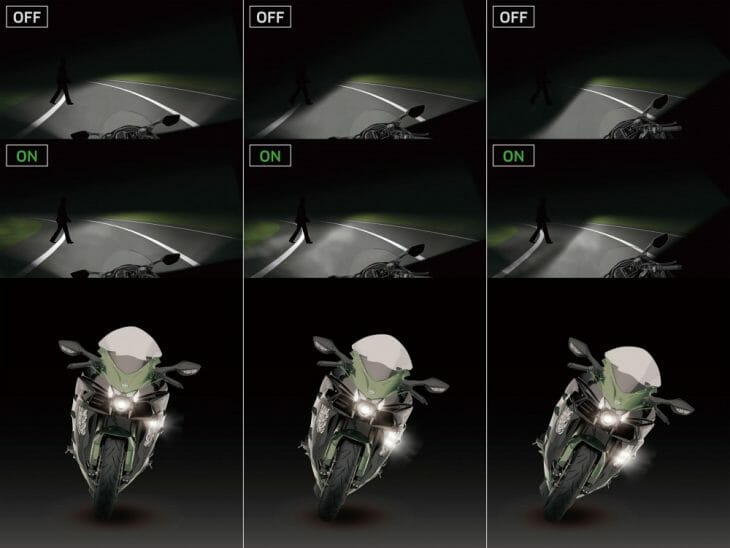The world’s most powerful sport touring motorcycles are put on show in New York

The supercharged Kawasaki H2 SX and SE sport touring machines have been shown to a salivating U.S. public in New York today, marking the first time Kawasaki has unveiled a derivative of the H2 and H2 R sportbikes that debuted in 2016.
We have had a quick First Look at the H2 SX and SE from the EICMA Show in Milan a few weeks back, but this time we can delve a little deeper under the skin of what is undoubtedly the world’s maddest sport touring motorcycle.
Far from being an H2 with saddlebags and a passenger seat, Kawasaki has extensively reworked the H2 in everything from powerplant to chassis and rider electronics in order to make the SX and higher spec SE.
The 999cc inline four-cylinder motor gets a new cylinder head with new, shorter duration cams, reworked pistons with a revised crown design and an increase in compression from 8.5:1 to 11.2:1, improving thermal efficiency and a decrease in the H2’s famous fuel consumption figures.
The supercharger gets a new impeller, intake chamber, cams, and exhaust, with the unit spinning up to 9.x times the crank speed via a 1.15x step gear and an 8x planetary gear.
The SX and SE share the same dog-ring-type transmission, but only the H2 SE will get the up and down Kawasaki Quick Shift system, more commonly found on the ZX-10RR and ZX-10R SE.
Other goodies that only the SE will get include the detailed TFT LCD display, a center stand, steel braided brake lines, heated grips, Kawasaki Launch Control system, a larger windscreen, a beautiful Emerald Blaze Green/Metallic Diablo Black color scheme and Kawasaki’s LED new Cornering Lights system.
The Cornering Lights are the first to appear on a Kawasaki and feature three LEDs on either side of the fairing, activated by the lean angle sensor in the Bosch IMU which increases the field of lighting at 10°, 20° and 30° of lean.
As for the chassis, it’s the same basic steel trellis structure as the H2 and H2 R but it’s been beefed up to accommodate two riders and luggage, compared to the single seat version of the H2. Payload has increased to 430 lb thanks to a stiffer main and passenger subframe.
The SX and SE get slightly more relaxed steering geometry with a 30° rake and a 15mm longer single-sided, forged aluminum swingarm Kawasaki claims is the lightest in the category.
Kawasaki has strangely chosen not to grace at least the H2 SE with the just-released electronic suspension fitted to the Ninja ZX-10R SE, instead leaving the suspension duties on both the SX and SE to full-adjustable 43mm KYB inverted forks up front and a fully-adjustable KYB monoshock at the rear—the shock also features high and low-speed compression, a new bottom linkage compared to the H2 and a remote adjustment knob for easy preload changes.
The SX and SE ride position had been somewhat altered to be more upright compared to the clip-on style of the H2, and Kawasaki has made two variations of the rider and passenger seat with a 15mm shorter option.
As expected, the SX and SE get a plethora of rider electronics via the five-axis Bosch Inertial Measurement Unit including three variable riding modes (Full, Middle offering 75 percent less power and Low, offering 50 percent less), Kawasaki Engine Braking, KIBS (Kawasaki Intelligent Anti-lock Brake System mated to Brembo M50 four-piston calipers) and Kawasaki Engine Brake Control.
The Ninja H2 SX will have a sticker price of $19,000 with the SE gaining a $3000 MSRP premium at $22,000.




























